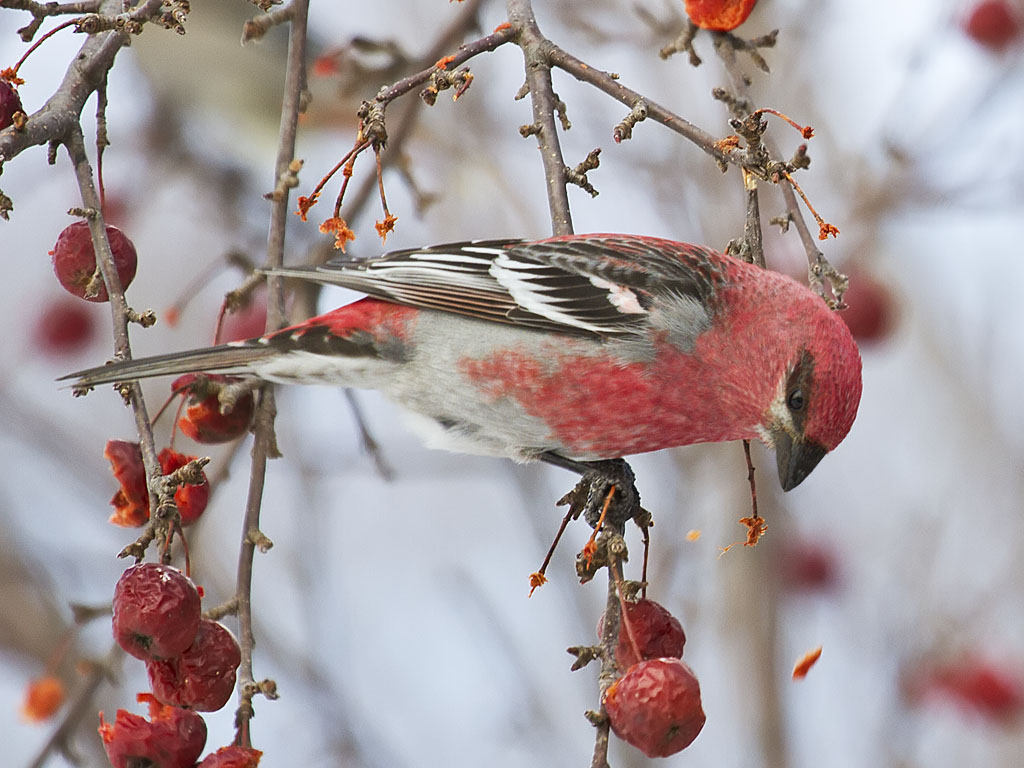The Pine Grosbeak, scientifically known as Pinicola enucleator, is a remarkable bird belonging to the finch family. Unlike other finches, it is the only species in its genus, Pinicola. This lovely bird can be found in coniferous forests throughout various regions including Alaska, the western mountains of the United States, Canada, Fennoscandia, and even extending across the Palearctic to Siberia.
Adopting a frugivorous diet, the Pine Grosbeak particularly enjoys feasting on small fruits, such as the vibrant rowans also known as mountain-ashes in certain parts of the world. Interestingly, this bird’s eating habits are influenced by the availability of fruit, which can vary significantly from year to year. As a result, the Pine Grosbeak, along with many other bird species residing in subarctic areas, exhibits irruptive behavior. During years of scarcity, these birds are known to venture long distances in search of suitable food sources, often venturing southward and/or descending to lower elevations compared to years where fruit crops are abundant.

This particular species is among the larger types of finches. It has an average length of 20 to 25.5 cm and weighs between 52 to 78 g, with the usual weight being around 56.4 g. The wingspan of a pine grosbeak measures approximately 33 cm. In terms of standard measurements, the wing chord ranges from 10.2 to 11.6 cm, the tail measures 7.8 to 9.5 cm, the bill is about 1.4 to 1.65 cm, and the tarsus measures between 1.9 to 2.3 cm.

Grown-up individuals of this species sport an impressive set of features. They flaunt a lengthy bifurcated black tail, along with black wings adorned with white wing bars. Their bill is quite substantial too. The male adults are especially striking, with a rosy-red head, back, and rump. Like their counterparts, males also possess black wings and tail, complemented by a conical beak. On the other hand, the adult females display an olive-yellow hue on their head and rump, while their back and underparts are covered in a grey shade. The appearance of young birds is not as striking as that of the adults. During their molting period, they tend to have a more subdued plumage overall, which can give them a shaggy appearance. When it comes to their sounds, their voices tend to differ depending on the geographic location. They emit a variety of calls such as a whistled “pui pui pui” or a melodious warble.

Distribution and Habitat:
Pine grosbeaks can be found breeding in the vast boreal forests of northern Eurasia and North America. They have a tendency to remain close to their breeding grounds or migrate short distances to the southern edge of the boreal forests. However, during years of higher population, they may embark on longer migrations to the southern boreal forests or even further south. This phenomenon is more prominent in the New World, where they have been spotted in areas well below their usual winter whereabouts, such as the northern Great Lakes region and northern New England in the United States. It is worth mentioning that pine grosbeaks are rarely seen in temperate regions of Europe, with only a few individuals, if any, reported each year in countries like Germany since 1980. These adaptable birds have also been observed residing in coniferous forests and other similar woodlands.

Behavior and Habitat:
The pine grosbeak can be mainly found in coniferous forests, where it chooses to nest on either a horizontal branch or in a fork of a conifer tree. This bird tends to stay in its habitat all year round, except in the northernmost regions or during times when food becomes scarce. In such cases, they may opt to migrate to more southern areas. During the breeding season, both male and female grosbeaks develop gular pouches that allow them to store seeds, which they later use to feed their offspring.

The Pine Grosbeak, a delightful bird known for its feeding habits in trees and bushes, has a unique diet consisting of seeds, buds, berries, and insects. During non-breeding periods, these sociable birds can often be observed feeding together in flocks.
Unfortunately, the conservation status of the Pine Grosbeak raises a cause for concern. This rare and captivating bird faces the threat of extinction, making its survival imperative. Due to its scarcity, spotting a Pine Grosbeak in the wild is a remarkable sight, further emphasizing the need for action against the environmental factors and deforestation that endanger its existence.
In conclusion, the Pine Grosbeak’s conservation status calls for immediate attention. By understanding their foraging behavior and the challenges they face, we can contribute to the preservation of this remarkable species.
